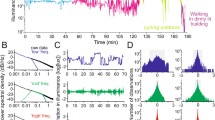Summary
The effects of continuous light on ultrastructural organization and sympathetic secretory responses of the rat parotid gland are reported.
After 50 days of continuous light exposure, the fine structure of the parotid gland exhibited features of enhanced secretory activity as judged by the striking development of rough endoplasmic reticulum and Golgi complexes, the depletion of secretory granules and the increased turnover of secretory cells. The secretory responses of parotid gland to isoproterenol revealed that continuous light induced a 30% increase in amylase release. This secretory hyperactivity appears to be related to a postsynaptic supersensitivity of sympathetic fibers of the autonomic nervous system.
Similar content being viewed by others
References
Asking B, Emmelin N, Gjorstrup B, Parsson H (1982) Parotid degeneration secretion of amylase in vitro in the rat following sympathectomy. Q J Exp Physiol 67:7–15
Axelrod J (1974) The pineal gland: a neurochemical transducer. Science 184:1341–1348
Babat H, Ben-Zvi R, Bdolah A, Schramm M (1967) The mechanism of enzyme secretion by the cell. 4. Effects of inducers, substrates and inhibitors on amylase secretion by rat parotid slices. Eur J Biochem 1:96–101
Bellavia SL, Sanz EG, Vermouth NT, Rins L, Aoki A (1981) Ontogenesis of alpha-amylase in rat parotid gland during postnatal development. Histochemistry 71:125–133
Deguchi T, Axelrod J (1972) Induction and superinduction of serotonin N-Acetyl transferase by adrenergic drugs and denervation in rat pineal organ. Proc Natl Acad Sci USA 69:2208–2211
Delfs U, Emmelin M (1974) Degenerations secretion of saliva in the rat following sympathectomy. J Physiol 239:623–630
Fleming WW, Trendelenburg U (1961) The development of super-sensitivity to norepinephrine after pretreatment with reserpine. J Pharmacol Exp Ther 133:41–51
Fischer EH, Stein EA (1961) Alpha-amylase from human saliva. Biochem Prep 8:27–33
Guzman JA, Peltzer LE, Graschinsky EA (1984) A 24-hour rhythm in the content of norepinephrine in the pineal gland of viscacha (lagostomus maximus maximus). Communicaciones Biologicas 2 (3):315–318
Haggi ES, Torres AI, Maldonado CA, Aoki A (1986) Regression of redundant lactotrophs in rat pituitary gland after cessation of lactation. J Endocrinol 111:367–373
Hertting G (1964) The fate of 3H-isoproterenol in the rat. Biochem Pharmacol 13:1119–1128
Karnovsky MJ (1965) A formaldehyde-glutaraldehyde fixative of high osmolality for use in electron microscopy. J Cell Biol 27:137 [Abstr]
Luchelli-Fortis MA, Stefano FJE, Perec CJ (1982) Degeneration activity of the pineal gland after sympathetic denervation. Naunyn-Schmiedebergs Arch Pharmacol 321:298–301
Lynch JL, Eng PJ, Wurtman RJ (1973) Control of pineal indole biosynthesis by changes in sympathetic tone caused by factors other than environmental lighting. Proc natl Acad Sci USA 70:1704–1707
Massa EM, Aoki A (1971) Simple method for purification of glutaraldehyde. Acta Physiol Pharmacol Latinoam 21:161–163
Perec CJ, Stefano FJE, Barrio Rendo ME (1973) Long-lasting supersensitivity after 6-hydroxydopamine in the submaxillary gland of the rat. J Pharmacol Exp Ther 186(2):220–229
Perec CJ, Stefano FJE, Tumilasci OR (1977) Secretory effects of 6-hydroxydopamine in normal and denervated submaxillary gland of the rat. Naunyn-Schmiedebergs Arch Pharmacol 298:245–253
Peustner ICW, Perec CJ, Stefano FJE (1979) Effects of sympathectomy on the in vitro alpha and beta-responses of the parotid gland. Naunyn-Schmiedebergs Arch Pharmacol 308:217–221
Schneyer CA, Hall HD (1966) Function of rat parotid gland after sympathectomy and total postganglionectomy. Am J Physiol 211(4):943–949
Shannon IL, Suddick RP (1973) Effects of light and darkness on human parotid salivary flow rate and chemical composition. Arch Oral Biol 18:601–608
Stefano FJE, Perec CJ (1981) Denervation supersensitivity in salivary glands. Trends Pharmacol Sci 2:107–109
Stefano FJE, Perec CJ, Tumilasci OR (1974) Changes in neuronal uptake and metabolism of, and sensitivity to, norepinephrine during the degeneration secretion in the rat submaxillary gland. J Pharmacol Exp Ther 191(3):403–417
Takahashi K, Inoue K, Takahashi Y (1977) Parallel shift in circadian rhythms of adrenocortical activity and food intake in blinded and intact rats exposed to continuous illumination. Endocrinology 100:1077–1097
Torres AI, Aoki A (1985) Subcellular compartmentation of prolactin in rat lactotrophs. J Endocrinol 105:219–225
Wurtman RJ, Axelrod J, Sedvall G, Moore RY (1967) Photic and neural control of the 24-hour norepinephrine rhythm in the rat pineal gland. J Pharmacol Exp Ther 157(3):487–492
Author information
Authors and Affiliations
Rights and permissions
About this article
Cite this article
Chiarenza, A.P., Sanz, E.G., Vermouth, N.T. et al. Effects of continuous light on rat parotid gland structure and reactivity. Anat Embryol 179, 497–501 (1989). https://doi.org/10.1007/BF00319593
Accepted:
Issue Date:
DOI: https://doi.org/10.1007/BF00319593



